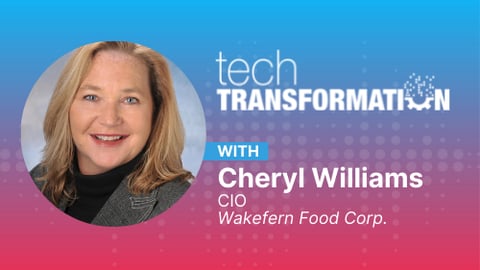Owning the Cycle of a Promising Future: Up Close With Visionet’s Werner Graf
With more than three decades in the consumer goods industry, Werner Graf has seen and met most industry challenges from a variety of vantage points. His experience has spanned operational, strategic, and consultancy roles in such companies as Procter & Gamble, Ernst & Young, IBM, and Tata. Currently the Chief Customer Officer of Visionet, he’s now primarily focused on digital, analytics, cloud, and supply chain solutions.
As a CGT/RIS Executive Council member, Graf is a frequent contributor to our retail and CPG communities, and he recently shared his thoughts on some of today’s most pressing issues, including what just might be the most exciting commerce opportunity on the horizon.
CGT: You've written about some of the most potentially impactful advances in sustainability in the past — what's impressed you in the last few years with regards to CPG's sustainability efforts?
Today’s consumer products industry drives a large share of the world’s garbage; therefore, CPG execs have a unique responsibility to own the cycle, not just the product. The responsibility doesn’t stop when the detergent is used up, the Twinkie eaten, or the razor discarded. CPG leaders (and retailers given the volume of private labels) increasingly acknowledge that they are stewards of the entire product lifecycle, and this is impressive. This acknowledgement will eventually lead to designing products with the ultimate end in mind being reconstitution and environmental impact, not consumer consumption.
EC Member Shares
How long have you been with Visionet?
Almost two years
Which book is on your nightstand or to-do list?
1) “Maverick, A Biography of Thomas Sowell,” a brilliant economist and social thinker
2) “The Autobiography of Calvin Coolidge,” who was, in my opinion, one of our five greatest presidents
Favorite food?
Easy: My Sicilian grandmother’s red sauce (or gravy, as the Italians say — which is technically true since all good southern Italian Marinaras are meat-based). Each year, my daughters and I set aside a day of cooking dedicated to my Grandmother Salerno.
Fill in the blank: "In 2022, I can't wait to …”
Honestly, every day is a blessing, and there are so many things I can’t wait to do that it would be like choosing a star from the sky.
Going forward, sustainability can be greatly enhanced by two things: biodegradability and reuse. This is largely a function of packaging. There is good progress here, but it needs acceleration and extensive collaboration with the entire ecosystem — source material, packaging, processing, transportation, consumers, and then finally recyclers and waste management companies — all of which should be at the table at the same time.
What is not helpful, in my humble opinion, is the cult-like, wear-it-on-your-sleeve, reverence paid to carbon footprints, elimination of fossil fuels, and cosmetic bans on certain items of low impact like grocery store bags and straws. These false gods are often pursued by execs and politicians for cosmetic effect, using broad statements while beating their chests about how much they care.
Unfortunately, efforts against these false gods are almost always accompanied by 1) reduction in individual choice; 2) reduced living standard; and/or 3) great expense sans any tangible measurable results. You’d have to ban straws and grocery bags for 100 years to equal one year of plastics packaging. Reducing your carbon footprint has no discernable effect whatsoever on tomorrow’s temperature. It’s absurd. These are costly distractions which smack of praying in the public square so all the neighbors see how pious you are. Execs should stop it.
Rather, more time should be spent on doing hard things like driving sensible and consistent recyclable standards, developing degradable containers, and investing in cutting-edge materials and reclamation technology to reduce and clean up waste. Imagine, for example, if all packaging was biodegradable over a 3 or even 5 year period—waste problem solved! In the meantime, we can’t keep using the ocean as a dumping ground, and the goal should be to correct this without reducing the standard of living.
Serious effort should be spent on educating consumers that food isn’t bad until it goes bad. It always amazes me when some loud proponent of “being green” throws out half the refrigerator because the milk is past its “best by” date having never tasted it. “Waste not, want not,” as the good Dr. Franklin would say. Or, looking way back, even Jesus after feeding the masses instructed his team to gather up the leftovers so that “nothing is lost or wasted.” I mean, if a man who could at any time miraculously feed thousands of people wasn’t wasting his food, perhaps we should follow the example.
CGT: There's lots of hype that the term "omnichannel" is dead. Do you think this is accurate?
Well, I don’t know what the context is of that hype, but given my definition of “omnichannel,” I think any news of its death has been greatly exaggerated. More than ever, buyers want to buy on convenience: any time and any place. Retailers who are there and easy to buy from have a better chance of selling.
CGT: What do you see as some of the most promising future commerce opportunities?
I think we’ve just scratched the surface on 3D printing, which has the promise to turn commerce on its head. Imagine a world where many of the items you consume require no transportation energy or production waste? Imagine instead of assembling your blender in China and then shipping it in containers across oceans, stevedoring it to a yard, loading it to a doublestack and again on the other side to a truck, shipping and unloading it to a distribution center, loading and shipping it to a store, buying gas on your way to the store to buy it — imagine if you just downloaded the design schema and printed it at your home?
Talk about going green! Think your blender is too complicated a machine to replicate? A Boston University research team just used 3D printing technology to develop a beating miniature replica of a human heart. They used nanotechnology and married it with tissue engineering. The “minipump” is just 3 square centimeters large and features an acrylic scaffold 3D printed using “two-photon direct laser writing.” Tiny acrylic valves within the structure open and close to control the flow through miniature arteries and veins.
To make the device beat, the researchers also integrated heart muscle cells called cardiomyocytes, which were differentiated from pluripotent stem cells. What everyday item that you use in your home is as complicated?
CGT: How can brands and retailers better prepare for these opportunities?
If they can do a complex 3D print achievement like replicating a human heart now, history teaches us that there will be an acceleration from here on out to reduce the cost and mass distribute the technology. It’s only a matter of time, and it won’t be long.
All manufacturers and retailers should be running future-state scenarios on the commercialization of 3D printing right now. Get ready for a Star Trek replicator, first in a store near you to make your shoes or custom flatware, and then in your garage for miscellaneous items, and then in your kitchen. Do today’s consumer product and retailing companies know what their role will be in that world?
CGT: The Executive Council focuses on helping consumer goods companies and retailers better collaborate. In your view, how can they become better trading partners in 2022?
Transparency. It helps everything. The truth will set your partnerships free.
CGT: What are some of the emerging technologies that you think will bring about the most change in the next 5-10 years?
Well, I’ve been in IT for most of my career, and I can honestly say that the “emerging” technologies now are more “evolving” technologies and “trending” technologies. Obviously digital, cloud, analytics, etc., are always moving forward and there are new strategies like headless architecture that capitalize on the progression in these areas. Things are always getting faster, smarter with more capacity. Blockchain opens up a digitization of the chain of custody and currency and the virtual reality stuff is fun. My firm specializes in leveraging IT to drive innovation across the enterprise and they’re all important.
That said, in my opinion, the real emerging technologies that will change the game going forward are more physical then virtual. We already talked about 3D printing, but there is tremendous progress in materials and nano-technology which has the potential to take a lot of weight out of products and packaging, thereby changing the shipping game completely. Automation, robotics, drone, sensors, and AI will combine to drive transportation, warehouse, operations, and customer service across the demand chain to new levels. Harkening back to our sustainability conversation, packaging can reach new milestones in biodegradability with the right attention and sponsorship.
Frankly, these emerging technologies will solve a lot of the problems that people are worried about — from clean water, food availability, and energy to our waste problems. And there are others: We could probably switch to clean, safe, third-generation nuclear tomorrow if it wasn’t so scary to so many people.
These technologies will also drive exploration of the oceans, the subterranean and space. If we can get out of our own way, unleash the free market and individual ingenuity around emerging tech, it will be a bright future indeed.








